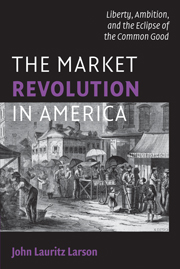Book contents
- Frontmatter
- Contents
- Acknowledgments
- Introduction: What Do We Mean by a Market Revolution in America?
- 1 First Fruits of Independence
- Interlude: Panic! 1819
- 2 Marvelous Improvements Everywhere
- Interlude: Panic! 1837
- 3 Heartless Markets, Heartless Men
- 4 How Can We Explain It?
- Epilogue: Panic! 2008, Déjà vu All over Again
- An Essay on the Sources
- Index
Interlude: Panic! 1837
Published online by Cambridge University Press: 05 June 2012
- Frontmatter
- Contents
- Acknowledgments
- Introduction: What Do We Mean by a Market Revolution in America?
- 1 First Fruits of Independence
- Interlude: Panic! 1819
- 2 Marvelous Improvements Everywhere
- Interlude: Panic! 1837
- 3 Heartless Markets, Heartless Men
- 4 How Can We Explain It?
- Epilogue: Panic! 2008, Déjà vu All over Again
- An Essay on the Sources
- Index
Summary
The years 1835 and 1836 showed a spike in American prosperity like nothing ever seen before. Cotton and foodstuffs poured forth into the markets of the world; investment capital flowed back in a virtual torrent as rich men in Europe and Britain scrambled to own a piece of the rising economic phenomenon that was the United States. Land sales boomed, cotton prices soared (driving up the price of land and slaves as well); the vast continental interior succumbed to parades of pioneers who stripped the land of timber, replacing it with cotton, hemp, wheat, corn, cattle, and hogs. Brilliantly, the tools of the market revolution – productive machinery, transportation improvements, easy credit, and marketing facilities – delivered fortunes to thousands of entrepreneurs and promised the same to tens of thousands more who lined up to emulate the successful. Then, between February and June 1837, it all fell to pieces again. Brokers failed in London, Paris, and all over the United States. Investment houses returned bills unpaid, leaving their correspondents holding worthless promissory paper. In May, banks in New York, Philadelphia, Providence, Baltimore, and New Orleans suspended specie payments and called in their loans. Suspension of payments interrupted credit, and the absence of credit brought to a halt the flow of goods and services throughout the system.
The Panic of 1837 cut a wide swath of injury largely because so many households now depended on the integrated market economy.
- Type
- Chapter
- Information
- The Market Revolution in AmericaLiberty, Ambition, and the Eclipse of the Common Good, pp. 92 - 97Publisher: Cambridge University PressPrint publication year: 2009



